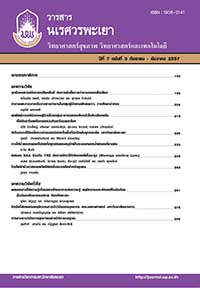ผลของการให้ความรู้เรื่องฉลากโภชนาการต่อความรู้ พฤติกรรมการใช้ข้อมูลโภชนาการและทัศนคติต่อรูปแบบการนำเสนอข้อมูลโภชนาการในนักเรียนชั้นมัธยมศึกษา ตอนปลาย จังหวัดพะเยา
Keywords:
ฉลากโภชนาการ, สัญลักษณ์โภชนาการ, ความรู้, พฤติกรรม, ทัศนคติ, Nutrition labels, nutrition label scheme, knowledge, behavior, attitudeAbstract
ปัญหาภาวะน้ำหนักเกินและภาวะอ้วน เป็นปัญหาสุขภาพที่ทวีความรุนแรงขึ้น ซึ่งเกิดจากการมีพฤติกรรมการบริโภคและวิถีชีวิตที่ไม่เหมาะสม กลุ่มนักเรียนระดับชั้นมัธยมศึกษาเป็นกลุ่มหนึ่งที่มีความเสี่ยงต่อภาวะอ้วนและน้ำหนักเกิน การศึกษาครั้งนี้เป็นการศึกษากึ่งทดลอง เพื่อศึกษาผลของการให้ความรู้เรื่องฉลากโภชนาการต่อความรู้ พฤติกรรมการใช้ข้อมูลโภชนาการในการตัดสินใจเลือกอาหาร และทัศนคติต่อรูปแบบการนำเสนอข้อมูลโภชนาการ 4 รูปแบบ ได้แก่ ฉลากโภชนาการแบบเดิม สัญลักษณ์โภชนาการแบบ FSA สัญลักษณ์โภชนาการแบบ GDA และสัญลักษณ์โภชนาการแบบ GDA ที่ระบุสีสัญญาณจราจร (Color- coded GDA) ของนักเรียนชั้นมัธยมศึกษาตอนปลายในจังหวัดพะเยา โดยเปรียบเทียบคะแนนความรู้และพฤติกรรมก่อน-หลังการให้ความรู้เรื่องโภชนาการและฉลากโภชนาการด้วยวิธีการบรรยายและแจกแผ่นพับ กลุ่มตัวอย่างได้จากการสุ่มอย่างง่ายจากรหัสประจำตัวนักเรียน วิเคราะห์คะแนนความรู้โดยใช้สถิติ Dependent t-test และเปรียบเทียบพฤติกรรมและทัศนคติโดยใช้สถิติ Mcnemar
ผลการศึกษาพบว่า กลุ่มตัวอย่างจำนวน 181 คน มีความรู้เกี่ยวกับโภชนาการและความรู้เรื่องสัญลักษณ์โภชนาการเพิ่มขึ้น อย่างมีนัยสำคัญทางสถิติ ส่วนด้านพฤติกรรมการใช้ฉลากโภชนาการในการเลือกซื้ออาหารของกลุ่มตัวอย่าง พบว่าพฤติกรรมการอ่านรายละเอียดของฉลากโภชนาการเวลาเลือกซื้ออาหาร มีระดับการปฏิบัติที่เพิ่มขึ้น อย่างมีนัยสำคัญทางสถิติ พฤติกรรมก่อนและหลังการให้ความรู้ในประเด็นอื่นๆนั้นไม่แตกต่างกันทางสถิติ ในส่วนของทัศนคติต่อรูปแบบการนำเสนอข้อมูลโภชนาการ พบว่า ด้านความครบถ้วนของข้อมูล และด้านการสนับสนุนให้นำไปใช้ในผลิตภัณฑ์ กลุ่มตัวอย่างมากกว่าร้อยละ 60 เห็นด้วยกับฉลากโภชนาการแบบเดิม ด้านประโยชน์ต่อการตัดสินใจเลือกซื้ออาหาร ด้านการนำไปใช้เปรียบเทียบข้อมูลสารอาหาร และด้านการนำเสนอให้ผู้บริโภคสามารถเข้าใจได้ง่าย ส่วนใหญ่เห็นด้วยกับสัญลักษณ์โภชนาการแบบ FSA
การให้ความรู้ในเรื่องโภชนาการและฉลากโภชนาการเป็นกระบวนการที่ช่วยให้นักเรียนมีความรู้เรื่องโภชนาการและฉลากโภชนาการเพิ่มขึ้น แต่มีผลต่อการเปลี่ยนแปลงพฤติกรรมการใช้ฉลากโภชนาการไม่มากนัก ส่วนการเพิ่มสัญลักษณ์โภชนาการจะทำให้ง่ายต่อความเข้าใจและนักเรียนส่วนใหญ่ยังคงต้องการใช้ควบคู่กับกรอบข้อมูลโภชนาการแบบเดิมเพื่อช่วยในการแสดงรายละเอียดข้อมูลในการตัดสินใจเลือกซื้ออาหาร
Effect of provision of nutrition label education on knowledge, nutrition Information utilization behavior and attitude toward nutrition label scheme among high school students, Phayao Province
Rujira Panya1* and Hathaikan Chowwanapoonpohn2
1 Pharmacist, Department of Pharmacy, Dokkhumtai Hospital, Muang Dokkhumtai, Phayao Province 56120
2 Department of Pharmaceutical Care, Faculty of Pharmacy, Chiangmai University, Chiangmai Province 50200
Obesity and overweight are a crucial health problem and has increased continuously due to the improper consumption habits and lifestyle. Especially, high school students are at high risk. This quasi-experimental study aims to examine the effects of nutrition label education on knowledge, nutrition information utilization behavior and attitude toward the 4 types of nutrition label scheme: traditional label, FSA label, GDA label, and color-coded GDA in Phayao high school students. Nutrition knowledge and Behavior were measured by comparing the scores of pre-test and post-test. The intervention of the study was establishing the education program using lecturing and leaflets providing. The subjects were randomized by simple random sampling from a student identification number. Nutrition knowledge was measured by comparing the scores of pre-test and post-test using dependent t-test statistics. Behavior and attitude were compared by using Mcnemar statistic.
The results showed that 181 subjects had increased statistically significant score in nutrition and nutrition label knowledge. For nutrition label using behaviors before food buying decision, subjects had increased statistically significant in frequency of nutrition label reading behavior. However other behaviors were not statistically different. In addition, the attitude toward the nutrition label scheme, more than 60 of the sample preferred traditional label because it provides complete information and could apply to practical use. They also preferred FSA label scheme because it had uncomplicated information and provided benefit to compare the nutrition for food selection.
Nutrition label education could improve knowledge of nutrition, however, the education did not seem to greatly change nutrition information utilization behavior. In addition, The most subjects need to use traditional nutrition label together with other nutrition label schemes to provide simple information for helping food buying decisions
Downloads
How to Cite
Issue
Section
License
ผู้นิพนธ์ต้องรับผิดชอบข้อความในบทนิพนธ์ของตน มหาวิทยาลัยพะเยาไม่จำเป็นต้องเห็นด้วยกับบทความที่ตีพิมพ์เสมอไป ผู้สนใจสามารถคัดลอก และนำไปใช้ได้ แต่จะต้องขออนุมัติเจ้าของ และได้รับการอนุมัติเป็นลายลักษณ์อักษรก่อน พร้อมกับมีการอ้างอิงและกล่าวคำขอบคุณให้ถูกต้องด้วย
The authors are themselves responsible for their contents. Signed articles may not always reflect the opinion of University of Phayao. The articles can be reproduced and reprinted, provided that permission is given by the authors and acknowledgement must be given.








